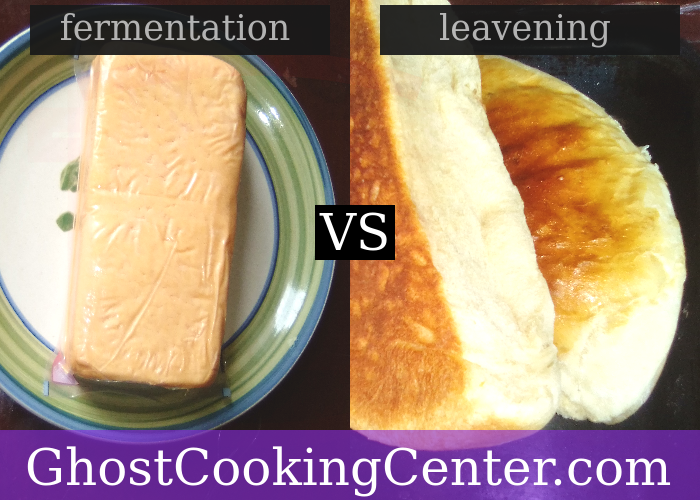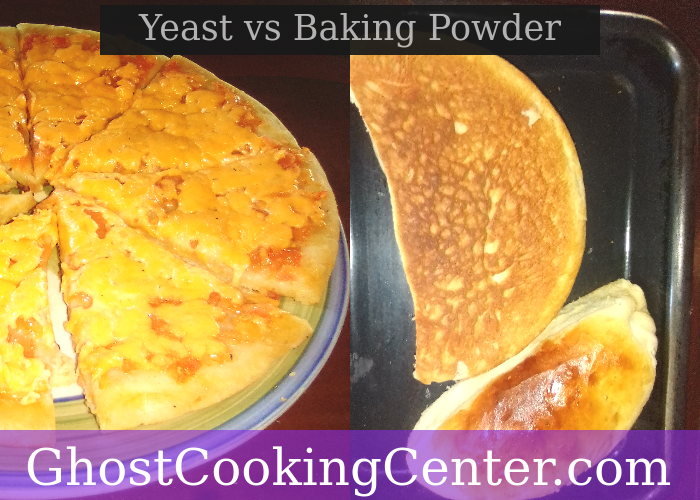Difference between fermentation and leavening

When viewing baking videos or reading baking articles or recipes, you may notice something interesting: the word "fermentation" is typically used interchangeably with the word "leavening". And this kinda raises the question as to whether these TWO words have the same meaning or not, and if they don't have the same meaning, why are they used interchangeably?
So in this article, we will be going through the difference between fermentation and leavening and we'll also explain why the two words are sometimes used interchangeably, although they don't have the same meaning.
Leavening is the formation of air bubbles in a food(bread, pizza, etc) and fermentation is a biological process in which microorganisms break down carbohydrates and produce alcohol or lactic acid. The reason the TWO terms are sometimes used interchangeably is that one way in which leavening is achieved is through fermentation, alcohol fermentation in particular.
What is fermentation

Fermentation is a process in which microorganisms break down carbohydrates(starch or sugars) to produce lactic acid or alcohol in the absence of oxygen.
There are two main types of fermentation: lactic acid fermentation is when microorganisms produce lactic acid and alcohol fermentation is when microorganisms produce alcohol(ethanol). Another thing that makes lactic acid different from alcohol fermentation is the fact that it doesn't produce carbon dioxide like alcohol fermentation does.
Apart from taste enhancement, fermentation can be used for preservation purposes. Lactic acid fermentation is the one which is used for preserving foods and alcohol fermentation is used in other foods like bread and pizza to improve the flavor. According to Flipped-Out Food, "Cold fermenting the pizza dough is the only way to get great flavor into your pizza crust."
Moreover, fermented foods have health benefits. According to Healthline, "eating fermented foods can also boost the number of beneficial bacteria in our bodies."
While pizza dough is typically fermented overnight in a fridge, other foods are fermented to be eaten after months or years. Here is a short list of some of these foods:
- Tempe: Tempe or tempeh is a cake-shaped food made from fermented soybeans. This food is traditional in Indonesia and it's also commonly eaten in the United States of America and its neighboring nations.
- Cheese: Cheese is a dairy product that has undergone the process of fermentation. Some of the common cheeses are cheddar and gouda, which are typically eaten with bread. Other cheeses(e.g: mozzarella) are used for making pizza.
- Yogurt: Made through the process of fermentation and acidification of milk by a bacteria called Lactobacillus bulgaricus. Yogurt is usually eaten as a dessert.
What is leavening

Leaven — leavening agent or raising agent is any substance — such as yeast or baking powder, which causes a dough(bread, pizza, cakes) to rise by forming air bubbles. And Leavening refers to the act or the process of raising a dough by adding a raising agent which then creates air bubbles in the food or dough. When food is leavened, it will grow in size, and hence become less dense, whereas unleavened food(e.g. bread, pizza, etc) is as dense as a brick.
While all raising agents raise food(bread, pizza, buns, scones, etc) by creating air bubbles(carbon dioxide) in the dough, they are so different and they produce carbon dioxide gas in different ways, and one may be more suitable than the others in some cases.
Leavening can be classified into THREE categories:
-
Biological Leavening:
A dough is leavened by using microorganisms, the microorganisms consume sugars and starch to release carbon dioxide, one example of a biological raising agent is yeast. Biological leavening is usually used when making foods like pizza, bread, etc.
-
Chemical Leavening:
Chemical leavening is triggered by chemical leavening agents, these leavening agents produce carbon dioxide when they come into contact with liquid and sometimes heat. Sodium bicarbonate is typically a part of chemical leavening agents and it creates carbon dioxide when reacts with an acidic substance. This type of leavening is typically used for foods like scones, cakes, cookies, etc.
-
Mechanical/Physical Leavening:
Mechanical or physical leavening is characterized by no chemical reaction and no biological processes involved. For example, mixing sugar with fats can cause leavening but doesn't involve any chemical reaction. This style of leavening is usually used with another leavening method, such as chemical or biological, and is typically used to further improve leavening.
Depending on the type of food you are baking or the type of flour you are using(high protein flour vs low protein flour), some raising agents can be more viable than others. Chemical leavening, along with mechanical leavening, is typically used for baked goods like scones and cakes, and biological leavening is used in making bread, pizza, etc.
While with great experience bread can be baked without leavening, it is usually not done so unless it's for religious or spiritual purposes like mentioned in the Torah. The air bubbles will make your bread or any baked food soft and fluffy.
Below is a short list of chemically leavened foods:
- breadsticks
- crackers
- biscuits
- muffins
- cookies
- waffles
- Cakes
How is leavening related to fermentation
Leavening and fermentation are totally different but are closely related. Leavening can be achieved by means of fermentation when microorganisms break down sugars and starch and then releases carbon dioxide which causes baked goods to rise. This is why for certain foods, such as pizza and bread, you typically have both fermentation and leavening. Yeast causes fermentation and leavening at the same time.
The only time when leavening is caused by fermentation is when yeast is used as a raising agent. Other raising agents like baking soda do not cause fermentation and this is because they do not rely on microorganisms.
Difference between leavening and fermentation
Fermentation breaks down sugars and leavening causes air bubbles
The first thing we'll look at is what each of the processes does to the food, and these processes do affect food differently.
With fermentation, we have a biological process in which microorganisms consume starch and sugars to form either alcohol or lactic acid, so lactic acid or ethanol is the product of fermentation.
Leavening is about the formation of air bubbles(usually carbon dioxide) which then inflate the food and make it lighter and soft. Although leavening can be achieved by using alcohol fermentation, it can also be achieved by other methods like chemical and physical.
Fermentation is biological and leavening can be biological, physical, or chemical
The processes(fermentation and leavening) are caused by different things and this is what we're about to discuss.
Fermentation can only be caused by microorganisms, either bacteria or fungi like yeast. These microorganisms consume the starch and sugars in the food and make either lactic acid or alcohol. When lactic acid is the product during fermentation, no carbon dioxide is released by the microorganisms.
Leavening can be achieved using biological, chemical, or mechanical processes. When leavening is achieved using a biological process, it is coupled with a fermentation process and that's why sometimes the word leavening is used interchangeably with fermentation.
Fermentation produces alcohol or acid and leavening produces gas
While fermentation can be used to cause leavening by forming carbon dioxide air bubbles, it does not always results in carbon dioxide. For example, with acid fermentation no carbon dioxide is produced, whereas with alcohol fermentation carbon dioxide gas is produced. This should also answer the question of whether you can raise the dough using acid fermentation and the answer is no. The only time fermentation can produce carbon dioxide is when alcohol is the product.
Leavening is simply the formation of air bubbles in the food, so gas(e.g. carbon dioxide) is the only product in this process.
Leavening is relatively faster than fermentation
When it comes to the time taken by these processes to occur, there's a huge variability.
Although certain measures can be taken to speed it up, fermentation is usually slow. It can take about 60 to 120 minutes depending on the temperature if triggered by yeast and it can take much longer than that when not triggered by yeast, for example, fermenting uncooked corn and water mixture for 24 hours at room temperature.
In case you are wondering "what does fermented corn taste like": it has a nice sour smell and taste, tastes like vinegar. Corn is typically fermented in some African countries like South Africa, Zimbabwe, Kenya, etc for preservative purposes. Unfermented cornmeal can spoil easily and quickly.
Leavening can be pretty fast, especially when triggered using physical or chemical action. By using a baking powder you can drastically speed up the leavening process and you don't have to leave the dough to sit out for some time before baking to allow leavening: leavening will happen during the baking process and it's triggered by increase an in temperature.
Summary
Leavening is the formation of air bubbles in the dough and fermentation is a process that involves the breaking down of sugars and the production of lactic acid or alcohol.
Leavening can be caused by biological, physical, or chemical activities and fermentation can only be triggered by biological activities.
Because fermentation is a biological activity, it is relatively slow. Microorganisms are just oblivious to the fact that you are trying to use them to ferment food, so they just slowly consume sugars and release carbon dioxide. Leavening can be pretty fast sometimes. For example, when using baking powder there's no need to wait for the dough to rise.
Further readings
- BYJUS. (n.d.). Types of Fermentation: Definition, Process, Advantages. [online] Available at: https://byjus.com/neet/types-of-fermentation/
- F, P. (2022). Cold-Fermented Pizza Dough. [online] Flipped-Out Food. Available at: https://www.flippedoutfood.com/cold-fermented-pizza-dough/ [Accessed 28 Jan. 2023].
- Link, R. (2017). 8 Fermented Foods to Boost Digestion and Health. [online] Healthline. Available at: https://www.healthline.com/nutrition/8-fermented-foods.
- Sciencedirect.com. (2011). Leavening Agent - an overview | ScienceDirect Topics. [online] Available at: https://www.sciencedirect.com/topics/agricultural-and-biological-sciences/leavening-agent.
- www.bakingbusiness.com. (n.d.). Chemical leavening ingredients: Out-of-the-box vs. custom | 2019-02-12 | Baking Business. [online] Available at: https://www.bakingbusiness.com/articles/47982-chemical-leavening-ingredients-out-of-the-box-vs-custom [Accessed 30 Jan. 2023].


